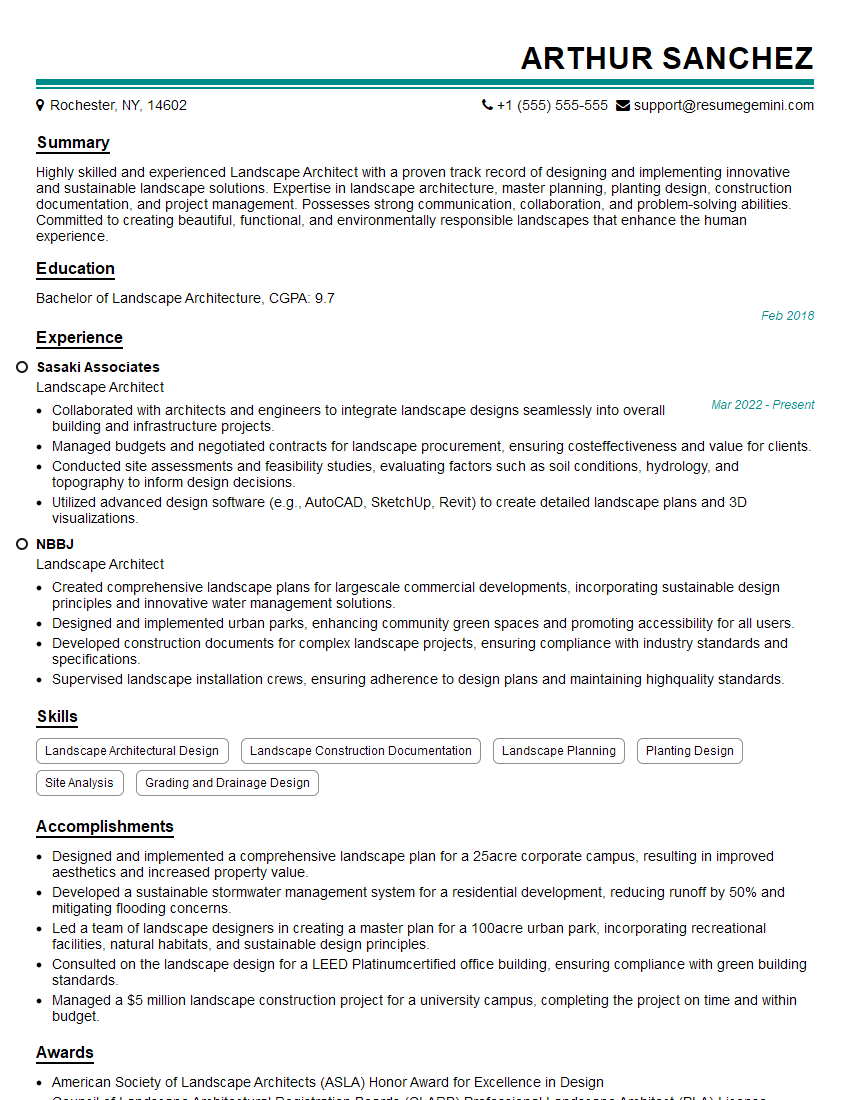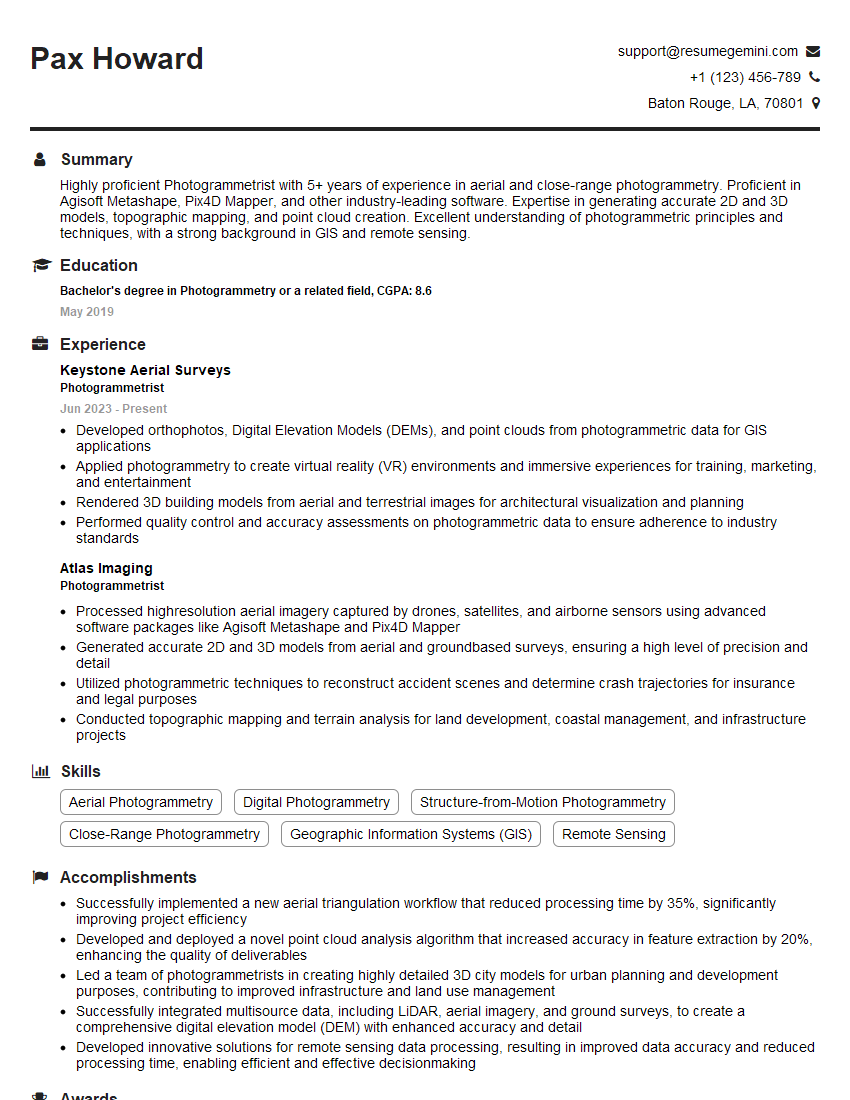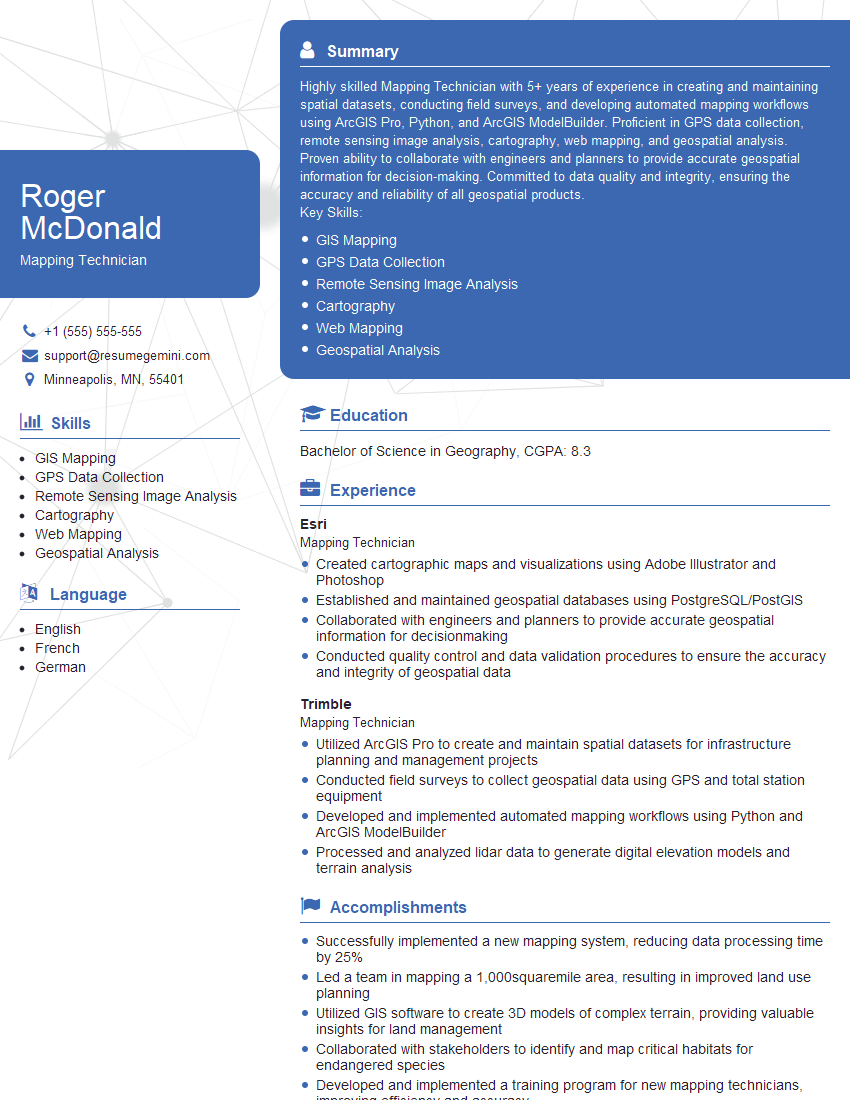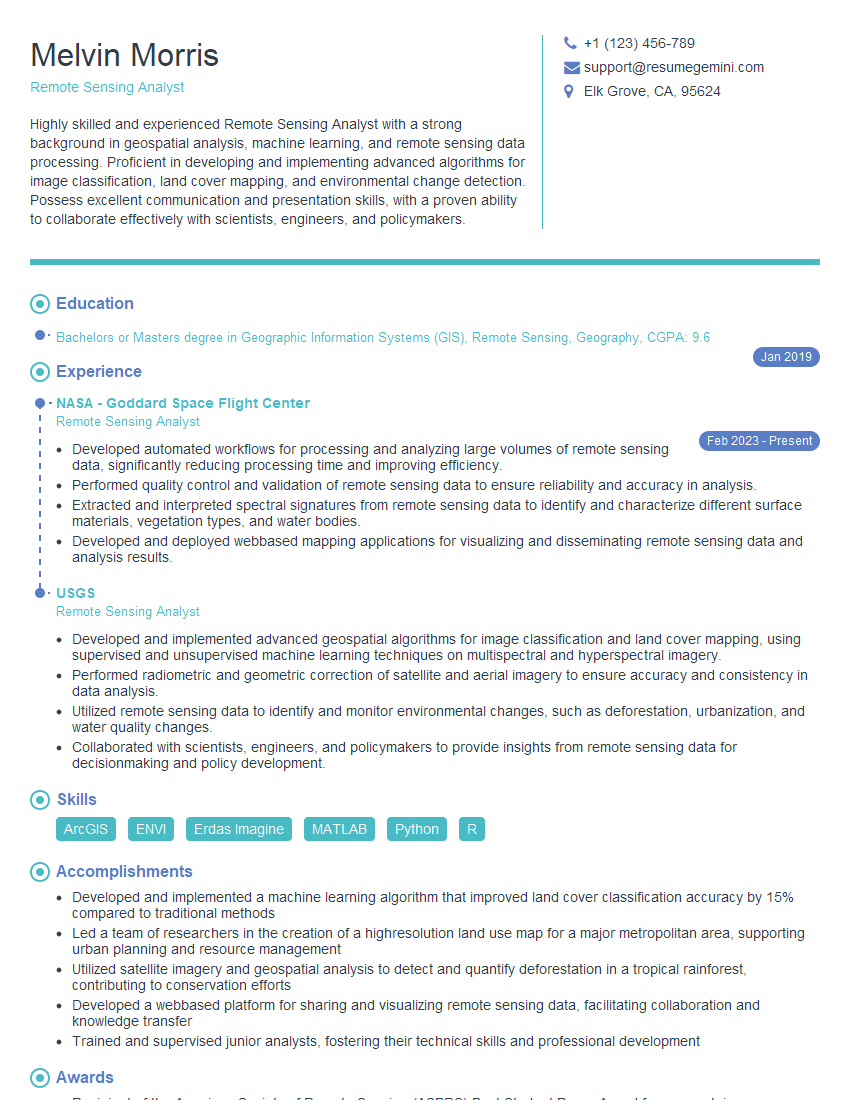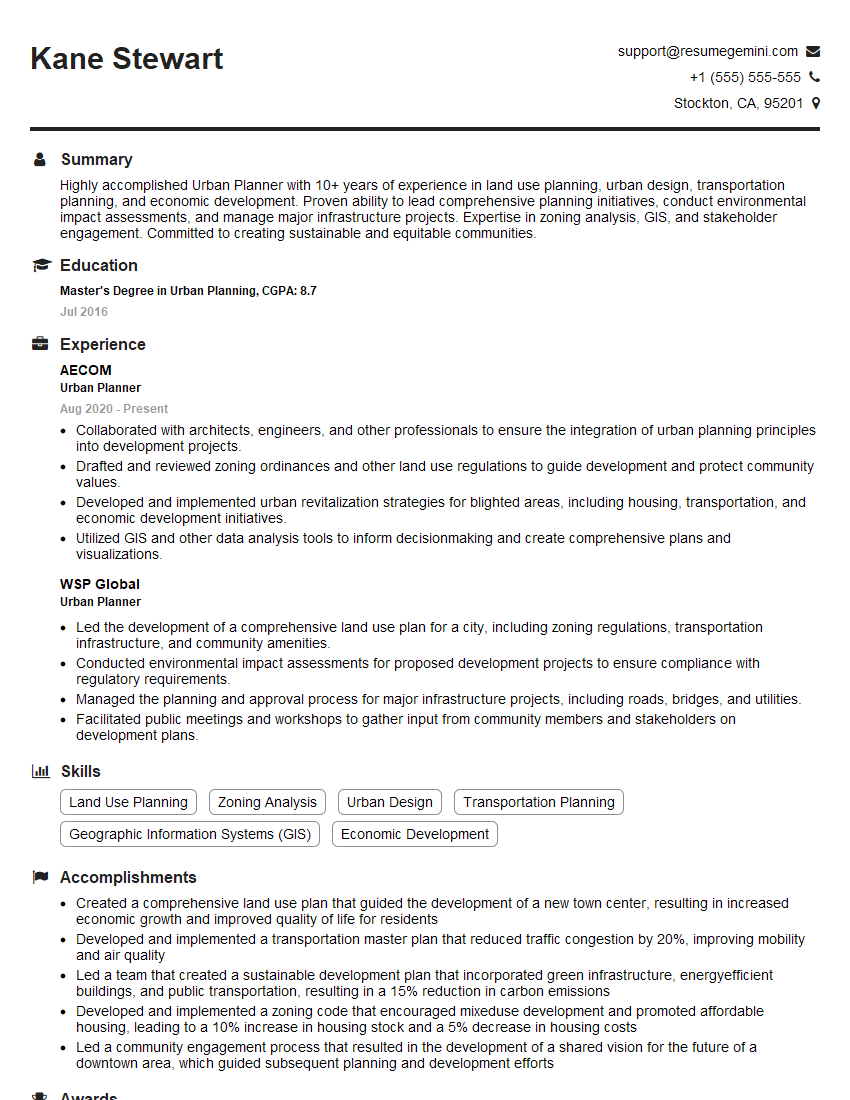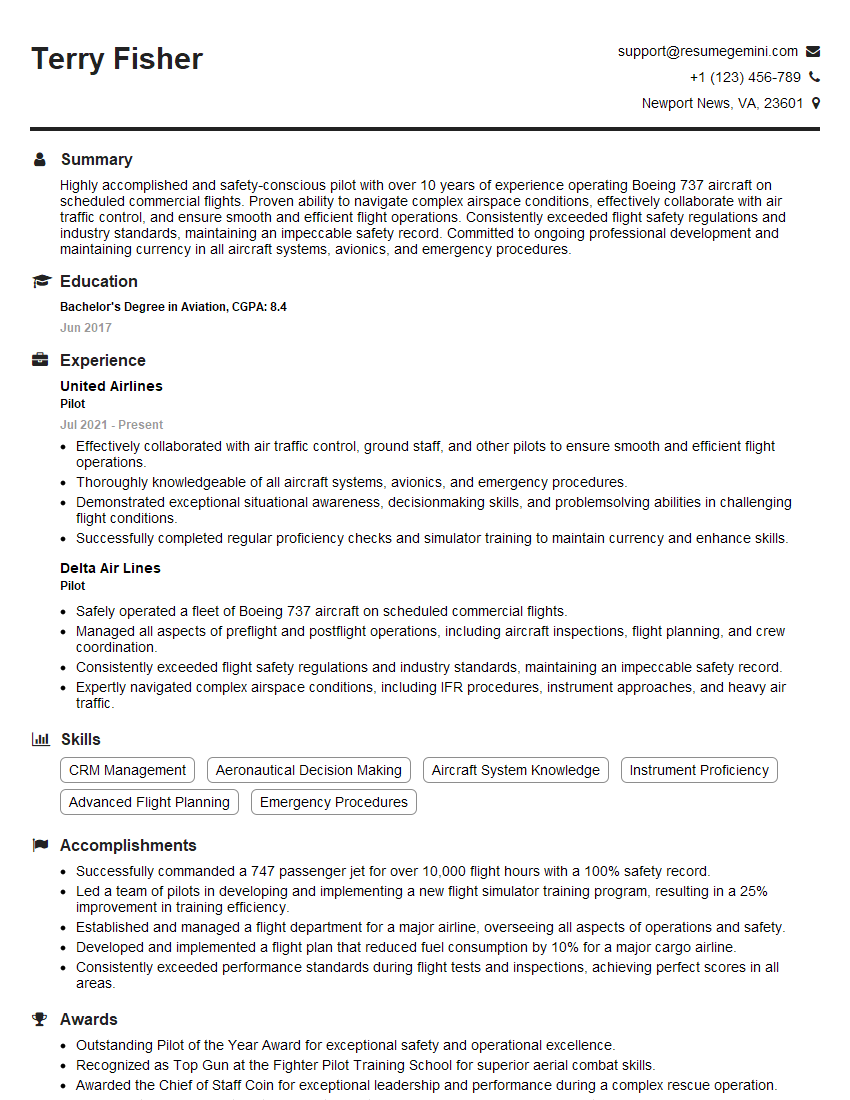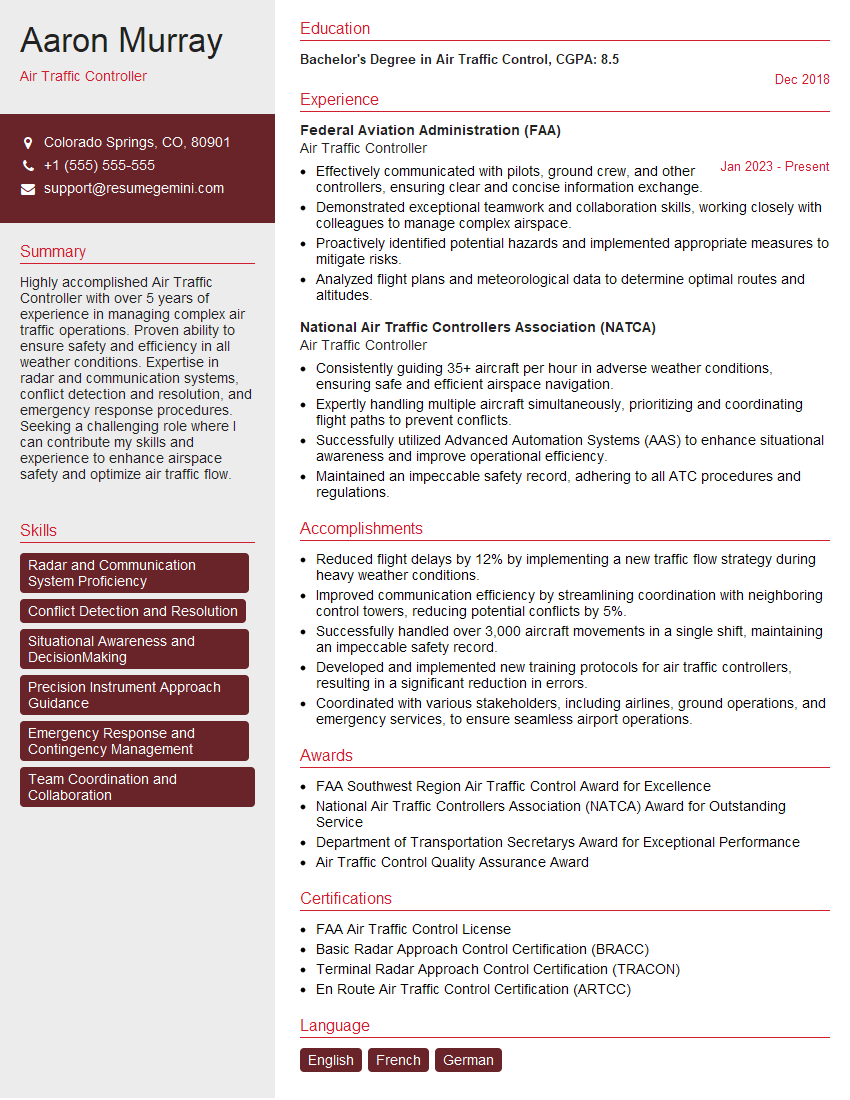Interviews are more than just a Q&A session—they’re a chance to prove your worth. This blog dives into essential Spatial orientation interview questions and expert tips to help you align your answers with what hiring managers are looking for. Start preparing to shine!
Questions Asked in Spatial orientation Interview
Q 1. Describe your understanding of spatial reasoning.
Spatial reasoning is the ability to understand and manipulate objects and their relationships in space. It’s about visualizing, mentally transforming, and reasoning about spatial information. This involves understanding concepts like distance, direction, shape, size, and relative position of objects. It’s not just about seeing; it’s about interpreting what you see and how things relate to each other in three-dimensional space. For example, assembling furniture from a flat-pack requires strong spatial reasoning skills, as you must mentally visualize how the pieces fit together to create the final product. Similarly, navigating a city without a map relies heavily on an intuitive understanding of spatial relationships between streets and buildings.
Q 2. Explain the concept of mental rotation.
Mental rotation is a crucial aspect of spatial reasoning. It’s the cognitive ability to mentally manipulate an object in three-dimensional space, such as rotating it in your mind’s eye. Imagine you’re given a shape, and you need to determine if it’s a mirror image of another shape. You wouldn’t physically rotate the shape; instead, you mentally rotate it to compare its features with the second shape. This ability is vital in fields such as engineering, architecture, and even playing 3D video games. For example, a surgeon must be able to mentally rotate organs and tools during a complex procedure. The speed and accuracy of mental rotation vary across individuals, and research suggests it can be improved with practice and training.
Q 3. How do you use visual aids to improve spatial understanding?
Visual aids are invaluable for improving spatial understanding. Diagrams, maps, models, and even simple sketches can transform abstract spatial concepts into concrete representations. For example, using a flowchart to represent the workflow of a process makes it easier to understand the sequence of steps and their interconnections. Similarly, a 3D model of a building helps architects, engineers, and clients visualize the design more effectively than blueprints alone. Interactive tools, such as virtual reality (VR) and augmented reality (AR) applications, enhance the engagement further, allowing users to explore spatial environments and manipulate objects virtually. When working with complex datasets, visualizations such as choropleth maps (that show data using color-coding on geographic regions) or 3D scatterplots (for spatial point data) can reveal patterns and relationships that are impossible to see in tabular data alone.
Q 4. How would you interpret a topographic map?
Interpreting a topographic map involves understanding its symbology and conventions. First, I would identify the map’s scale, north orientation, and legend. The contour lines are key – each line represents a constant elevation. The closer the contour lines are together, the steeper the slope. I would then look for features like water bodies (represented by blue lines), roads, buildings, and elevation points. By analyzing the contour lines, I can visualize the three-dimensional terrain, identifying hills, valleys, and ridges. Furthermore, the map’s legend helps in understanding the symbols used to represent different features. For instance, a brown dashed line might represent a trail, while a blue filled area represents a lake. I would use these elements to build a three-dimensional mental representation of the landscape, enabling me to understand the terrain’s characteristics and plan routes or analyze potential impacts.
Q 5. Describe your experience working with GIS software (e.g., ArcGIS, QGIS).
I have extensive experience using GIS software, particularly ArcGIS and QGIS. My expertise extends to data management, spatial analysis, cartography, and geoprocessing. In ArcGIS, I’m proficient in creating and managing geodatabases, performing spatial queries (such as buffer analysis and overlay analysis), and generating various map products. I’ve used QGIS for similar tasks, particularly appreciating its open-source nature and extensive plugin support. I’ve worked on projects involving analyzing crime data distributions using spatial autocorrelation, modelling potential wildfire spread based on terrain and vegetation data, and mapping infrastructure networks using network analysis tools. My projects have involved both raster (e.g., satellite imagery) and vector (e.g., shapefiles) data formats. I also possess experience in scripting using Python within these GIS environments to automate repetitive tasks and build custom tools.
Q 6. Explain your process for analyzing spatial data.
My process for analyzing spatial data typically begins with defining the research question or problem. Next, I acquire and assess the data quality, ensuring its accuracy, completeness, and spatial resolution are adequate for the task. This involves understanding the coordinate system and projections used. Then, I perform exploratory data analysis using appropriate visualization techniques (e.g., histograms, scatterplots, maps) to understand the data’s distribution and patterns. Depending on the research question, I apply suitable spatial analysis techniques. This may include geostatistical analysis (e.g., kriging for interpolation), spatial autocorrelation analysis, or network analysis. Finally, I interpret the results, draw conclusions, and present them effectively, often using maps, charts, and other visual aids. Throughout this process, I document every step for reproducibility and quality assurance.
Q 7. How would you identify spatial patterns in a dataset?
Identifying spatial patterns in a dataset requires a combination of visual inspection and quantitative analysis. I start by visualizing the data on a map, using appropriate symbology and color schemes to highlight potential clusters, outliers, and trends. For example, a heatmap can reveal high-density areas. Then, I employ quantitative techniques to confirm and quantify the observed patterns. Spatial autocorrelation analysis (e.g., Moran’s I) helps determine the degree of spatial clustering or dispersion. Spatial statistics such as Getis-Ord Gi* can identify hotspots and cold spots. Techniques like clustering algorithms (e.g., k-means clustering) can be used to group similar spatial entities based on their attributes. The choice of method depends on the type of spatial data and the research question. For instance, if I’m analyzing crime hotspots, I would use hotspot analysis to pinpoint high-risk areas for focused law enforcement.
Q 8. How would you represent spatial relationships in a diagram?
Representing spatial relationships in a diagram depends heavily on the type of relationship and the level of detail needed. Simple relationships can be shown with basic shapes and labels, while more complex ones might require specialized diagrams or even 3D models.
For instance, to show the relative location of buildings on a street, a simple 2D map would suffice, using icons for buildings and lines to represent streets. The relative positions of the icons show the spatial relationship.
- Proximity: Use proximity to show ‘near’ or ‘far’ relationships. Buildings close together on the map are close in reality.
- Direction: Arrows can indicate direction (e.g., Building A is north of Building B).
- Connectivity: Lines connecting shapes can represent paths or connections (e.g., a road network).
- Overlap/Containment: Nested shapes (one shape inside another) show containment (e.g., a house within a plot of land).
More complex relationships, like those involving elevation or three-dimensional structures, benefit from 3D modeling or specialized diagrams. For example, illustrating the spatial relationship between underground pipes and building foundations requires a cross-section view or a 3D model.
Q 9. Describe your experience with 3D modeling software.
I have extensive experience with various 3D modeling software packages, including Autodesk Maya, Blender, and SketchUp. My proficiency extends beyond basic modeling to include texture mapping, lighting, animation, and the integration of spatial data from GIS platforms. In my previous role, I used Maya to create detailed 3D models of urban environments for simulation and visualization purposes. This involved importing and manipulating large datasets of building footprints, terrain elevation data, and street networks. In another project using Blender, I developed interactive 3D models for educational purposes, focusing on the clear representation of complex spatial relationships, such as the interaction of tectonic plates or the flow of underground water systems.
I am also comfortable with various file formats commonly used in 3D modeling, such as .obj, .fbx, and .dae, and understand the importance of efficient workflow and data management in large-scale 3D modeling projects.
Q 10. How would you design a navigation system for a new city?
Designing a navigation system for a new city involves a multi-faceted approach, combining spatial data analysis with user-centered design principles. The first step would involve collecting comprehensive spatial data, including street networks, points of interest (POIs), public transport routes, and elevation data.
Next, I would leverage GIS software to process and analyze this data, creating a digital representation of the city’s spatial structure. This digital model would serve as the foundation for the navigation system.
- Data acquisition and processing: This includes surveying, mapping, and data integration from various sources.
- Route planning algorithms: Implementing efficient algorithms to calculate optimal routes based on distance, travel time, and mode of transport.
- User interface design: Creating a user-friendly interface for both mobile and desktop platforms, ensuring ease of navigation and information accessibility.
- Real-time updates: Integrating real-time traffic data and other dynamic information to provide users with the most up-to-date navigation information.
- Accessibility features: Ensuring the system is accessible to people with disabilities.
Finally, rigorous testing and user feedback would be crucial to refine and improve the system’s performance and usability. The system could integrate multiple modes of transportation and offer alternative routes based on user preferences and real-time conditions.
Q 11. How do you approach problem-solving in a spatial context?
My approach to problem-solving in a spatial context is systematic and iterative. I typically begin by clearly defining the problem, identifying the relevant spatial data, and choosing appropriate analytical techniques. This often involves visualizing the problem using maps, diagrams, or 3D models to gain a better understanding of the spatial relationships involved.
I then employ a range of spatial analysis tools and techniques, depending on the specific nature of the problem. This could include techniques such as spatial interpolation, proximity analysis, overlay analysis, or network analysis. Throughout the process, I emphasize data quality control and validation to ensure the reliability of the results.
Crucially, I always consider the context of the problem, including social, economic, and environmental factors. For example, simply finding the shortest route is not always the optimal solution; factors such as safety, accessibility, and environmental impact must also be considered.
Finally, I communicate my findings clearly and effectively using maps, charts, and reports tailored to the audience. I strongly believe in the importance of collaboration and seek feedback from stakeholders throughout the problem-solving process.
Q 12. Describe a time you had to use spatial reasoning to solve a problem.
During a project involving the optimization of emergency service response times, we faced the challenge of identifying optimal locations for new ambulance stations in a rapidly expanding city. The existing stations were unevenly distributed, leading to significant variations in response times across different areas.
We used spatial analysis techniques, specifically a combination of proximity analysis and network analysis, to model ambulance response times based on road networks, population density, and the location of existing stations. We then used a location-allocation model to identify potential new station locations that would minimize overall response times and improve service equity across the city.
This involved visualizing the spatial distribution of calls, response times, and population density using GIS software. The visual representation was essential in identifying underserved areas and in communicating our recommendations to stakeholders.
Q 13. Explain the difference between vector and raster data.
Vector and raster data are two fundamentally different ways to represent spatial information. Understanding their differences is crucial for selecting the appropriate data type for a specific application.
- Raster data represents spatial information as a grid of cells or pixels, each containing a value representing a particular attribute (e.g., elevation, temperature, land cover). Think of it like a digital photograph or a satellite image. Examples include satellite imagery, digital elevation models (DEMs), and scanned maps.
- Vector data represents spatial information using points, lines, and polygons. Points represent locations, lines represent linear features (like roads), and polygons represent areas (like buildings or land parcels). Each feature has associated attributes (e.g., street name, building height, land use). Examples include shapefiles, geodatabases, and KML files.
The choice between vector and raster depends on the application. Raster data is excellent for representing continuous phenomena (like elevation or temperature), while vector data is ideal for discrete objects with defined boundaries. Raster data can be simpler to visualize but often requires more storage space, while vector data is more precise for representing features but can be more complex to manage.
Q 14. How would you handle missing spatial data in an analysis?
Handling missing spatial data is a critical aspect of spatial analysis. The best approach depends on the nature and extent of the missing data, as well as the goals of the analysis.
- Identify the cause: Understanding *why* the data is missing is the first step. Is it due to data collection errors, natural limitations, or other factors? This helps choose the appropriate imputation strategy.
- Spatial interpolation: For continuous data like elevation, interpolation techniques like kriging or inverse distance weighting can estimate missing values based on the values of nearby data points.
- Data imputation: For categorical data, replacing missing values with the most frequent value or a value based on similar neighboring locations might be suitable. However, this should be done carefully to avoid introducing bias.
- Exclusion: In some cases, it might be best to exclude areas with significant missing data from the analysis, if it doesn’t significantly affect the results. This needs careful consideration, as excluding too much data can reduce the analysis’s validity.
- Sensitivity analysis: It’s important to assess the impact of different imputation methods on the results. Comparing the results with different approaches can help gauge the uncertainty introduced by missing data.
Documenting the handling of missing data is crucial for transparency and reproducibility. The methods used and their potential impact on the results should be clearly stated in any reports or publications.
Q 15. Describe your experience with geospatial data projection and transformation.
Geospatial data projection and transformation are crucial for representing the Earth’s curved surface on a flat map. Projection involves converting 3D coordinates (latitude and longitude) to 2D coordinates on a map, while transformation involves converting coordinates from one coordinate system to another. Different projections result in varying distortions in area, shape, distance, and direction. My experience involves working with various projections like UTM (Universal Transverse Mercator), Albers Equal-Area Conic, and Lambert Conformal Conic, selecting the most suitable projection based on the specific application and geographic area. For example, UTM is excellent for local-scale mapping because it minimizes distortion, but it’s unsuitable for global maps. I’m proficient in using tools like ArcGIS and QGIS to perform these operations, ensuring accuracy and consistency in spatial analysis.
I’ve successfully tackled projects involving transforming data from a Geographic Coordinate System (GCS) like WGS84 to a Projected Coordinate System (PCS) like UTM Zone 17N to accurately analyze distances and areas within a specific region. This included managing potential errors related to datum transformations, ensuring the transformed data’s accuracy is maintained for further analysis.
Career Expert Tips:
- Ace those interviews! Prepare effectively by reviewing the Top 50 Most Common Interview Questions on ResumeGemini.
- Navigate your job search with confidence! Explore a wide range of Career Tips on ResumeGemini. Learn about common challenges and recommendations to overcome them.
- Craft the perfect resume! Master the Art of Resume Writing with ResumeGemini’s guide. Showcase your unique qualifications and achievements effectively.
- Don’t miss out on holiday savings! Build your dream resume with ResumeGemini’s ATS optimized templates.
Q 16. How would you determine the optimal scale for a map?
Determining the optimal map scale is a balance between detail and overview. A large-scale map (e.g., 1:10,000) shows great detail but covers a small area, while a small-scale map (e.g., 1:1,000,000) shows a large area with less detail. The choice depends on the map’s purpose and the features being highlighted.
For instance, a detailed map showing individual buildings in a city would require a large scale, while a map showcasing the distribution of different land cover types across a country would need a smaller scale. I consider the level of detail needed, the extent of the area being mapped, and the intended audience when selecting a map scale. Often, I’ll create maps at multiple scales to cater to various needs. The map’s purpose is the ultimate deciding factor. For example, a map intended for navigation will require a different scale than a map for thematic analysis.
Q 17. Explain your understanding of spatial autocorrelation.
Spatial autocorrelation describes the degree to which nearby locations are similar. High spatial autocorrelation indicates that nearby locations share similar attributes (e.g., high crime rates in clustered neighborhoods), while low spatial autocorrelation suggests randomness in the spatial distribution. Understanding spatial autocorrelation is critical because ignoring it in spatial analysis can lead to inaccurate conclusions.
For example, if analyzing the spread of a disease, high spatial autocorrelation would suggest a contagious process, while low autocorrelation might indicate random outbreaks. I use Moran’s I or Geary’s C statistics to measure spatial autocorrelation, interpreting the results to understand the underlying spatial patterns. The understanding of spatial autocorrelation helps in selecting appropriate spatial statistical models and interpreting their outputs effectively.
Q 18. How would you create a thematic map from a dataset?
Creating a thematic map involves visually representing the spatial variation of a particular attribute. The process generally involves several steps:
- Data Preparation: Cleaning, transforming, and ensuring the data’s accuracy is critical.
- Classification: Grouping data values into classes (e.g., equal interval, quantile, natural breaks). Choosing the appropriate classification method is important for clear visual representation.
- Symbology Selection: Choosing appropriate colors, patterns, or symbols to represent different classes. Color selection needs careful consideration to avoid misleading interpretations. Consider colorblind accessibility!
- Map Layout Design: Creating a well-organized and informative map including a legend, title, scale bar, and north arrow. The visual design influences how effectively the map communicates information.
For instance, to create a thematic map showing population density, I would classify the population data into classes (e.g., low, medium, high) and then assign different colors to each class. The resulting map would show the spatial distribution of population density, highlighting areas with higher or lower concentrations.
Q 19. How would you use spatial analysis to identify potential hazards?
Spatial analysis is powerful for identifying potential hazards. Techniques like proximity analysis, overlay analysis, and spatial interpolation play a significant role. For example:
- Proximity Analysis: Identifying areas within a certain distance of a hazardous facility (e.g., a chemical plant). I would use tools such as buffer analysis to delineate these areas of potential risk.
- Overlay Analysis: Combining different layers (e.g., floodplains, population density, soil type) to identify areas at high risk of flooding and the number of people at risk.
- Spatial Interpolation: Estimating the hazard’s intensity at unsampled locations based on data collected from known locations. For instance, interpolating pollution levels from measurement points to generate a continuous surface.
By combining these techniques, I can create risk maps to inform emergency planning, land-use management, and resource allocation. For instance, I may use these techniques to determine evacuation routes in a wildfire prone area by combining elevation, wind direction, and vegetation data.
Q 20. Explain your understanding of coordinate systems (e.g., UTM, latitude/longitude).
Coordinate systems are fundamental for locating points on the Earth’s surface. Latitude and longitude form the Geographic Coordinate System (GCS), a spherical coordinate system based on Earth’s meridians and parallels. Latitude measures north-south position, and longitude measures east-west position.
The Universal Transverse Mercator (UTM) is a Projected Coordinate System (PCS) that projects the Earth’s surface onto a series of transverse Mercator cylinders. UTM divides the world into 60 zones, each spanning 6 degrees of longitude. It’s commonly used for mapping because it minimizes distortion within each zone. The choice between a GCS and a PCS depends on the application. GCS is suitable for global-scale analysis, while PCS is better for local-scale analysis where minimizing distortion is crucial. Understanding the differences is key to ensuring accurate spatial analysis.
Q 21. How would you interpret spatial statistics (e.g., spatial clustering, spatial regression)?
Spatial statistics provides tools for understanding spatial patterns and relationships. Spatial clustering analysis helps identify areas with unusually high concentrations of an event (e.g., disease outbreaks). Techniques like Ripley’s K-function and kernel density estimation are used to detect clusters.
Spatial regression models incorporate spatial autocorrelation to analyze the relationship between a dependent variable and multiple independent variables. Examples include spatial lag and spatial error models. Interpreting spatial statistics requires caution, as the results can be influenced by factors like spatial autocorrelation and edge effects. It’s essential to consider appropriate spatial autocorrelation tests, model diagnostics, and visualization techniques to accurately interpret the results and draw meaningful conclusions about the spatial processes underlying the data.
Q 22. How familiar are you with different map projections (e.g., Mercator, Lambert)?
Map projections are essential for representing the three-dimensional Earth on a two-dimensional map. Different projections distort various properties of the Earth, such as area, shape, distance, or direction. My familiarity extends to several common projections, including the Mercator, Lambert Conformal Conic, and Albers Equal-Area projections.
- Mercator Projection: Preserves shape and direction locally but significantly distorts area, especially at higher latitudes. Think of Greenland appearing much larger than South America – a classic example of Mercator’s area distortion. It’s commonly used in navigation because rhumb lines (lines of constant compass bearing) appear as straight lines.
- Lambert Conformal Conic Projection: Minimizes shape distortion and is commonly used for mapping areas that are relatively long in the east-west direction, like the United States. It’s good for representing regions with low latitudinal extent, maintaining relatively accurate shape and direction.
- Albers Equal-Area Conic Projection: Preserves area accurately but distorts shape and distance. This is ideal for thematic mapping where the relative sizes of different areas are crucial, such as showing population density across a state.
Choosing the appropriate projection is crucial for accurate spatial analysis. The choice depends on the specific application and the properties that need to be preserved.
Q 23. How do you ensure data accuracy and precision in spatial analysis?
Data accuracy and precision in spatial analysis are paramount. Ensuring both requires a multi-faceted approach:
- Data Source Validation: I rigorously evaluate the source of spatial data, checking its metadata for details on accuracy, precision, and the methodology used for data collection. This includes examining positional accuracy (how precisely a point is located) and attribute accuracy (the correctness of the data associated with a feature).
- Data Cleaning and Preprocessing: This crucial step involves identifying and correcting errors, inconsistencies, and outliers in the data. This might include removing duplicate points, smoothing lines, and filling in gaps based on established methodologies or using interpolation techniques.
- Spatial Data Validation: I use techniques like topology checks (ensuring features have proper geometric relationships) and spatial autocorrelation analysis to identify anomalies and errors in the spatial arrangement of data.
- Coordinate Systems and Projections: Consistent use of appropriate coordinate systems and map projections throughout the analysis is crucial. Errors can be introduced if data from different sources with incompatible coordinate systems are combined.
- Uncertainty Assessment: Understanding and quantifying uncertainty is vital. This involves explicitly recognizing and incorporating potential errors throughout the analytical process and reporting uncertainties in final results.
For example, when analyzing crime data, it’s essential to know the precision of the location data (e.g., is it reported to the address level, or just the census block?). This directly impacts the accuracy of any spatial analysis of crime patterns.
Q 24. Describe your experience with remote sensing data.
My experience with remote sensing data includes working with various satellite and aerial imagery, including Landsat, Sentinel, and aerial photographs. I have expertise in:
- Image Preprocessing: This involves tasks such as atmospheric correction, geometric correction, and orthorectification to remove distortions and improve the accuracy of the imagery.
- Image Classification: I use supervised and unsupervised classification techniques to categorize pixels into different land cover types (e.g., forest, urban, water) using algorithms like maximum likelihood classification or support vector machines.
- Image Analysis: I extract valuable information from imagery, such as vegetation indices (NDVI) to monitor plant health or calculate surface area changes to track deforestation.
- Integration with GIS: I’m proficient in integrating remote sensing data into GIS environments for spatial analysis and visualization.
For instance, I once used Landsat imagery to monitor changes in coastal wetlands over a decade, identifying areas of erosion and accretion. This involved extensive image processing, change detection analysis, and the creation of maps to communicate the findings effectively.
Q 25. Explain your approach to dealing with spatial data ambiguity.
Spatial data ambiguity arises when the location or attributes of a spatial feature are uncertain or imprecise. My approach to handling this involves:
- Data Fusion: Combining data from multiple sources can help reduce ambiguity. For example, integrating GPS data with street network data can improve the location accuracy of a point feature.
- Fuzzy Logic: Fuzzy sets and fuzzy logic can model uncertainty in spatial data. Rather than assigning crisp boundaries to features, fuzzy logic allows for gradual transitions between classes, reflecting the inherent ambiguity.
- Probabilistic Methods: Methods like Bayesian inference can be used to update the probability of different spatial interpretations based on available evidence. This is useful when dealing with incomplete or uncertain data.
- Sensitivity Analysis: Testing the sensitivity of analysis results to changes in the spatial data helps to quantify the impact of uncertainty.
Imagine mapping a coastline from aerial imagery. The exact boundary between land and water can be ambiguous due to tidal effects. Fuzzy logic helps to represent this ambiguity by defining a ‘transition zone’ with gradual membership in both land and water classes.
Q 26. How do you communicate complex spatial information to a non-technical audience?
Communicating complex spatial information to a non-technical audience requires clear and concise communication, avoiding technical jargon wherever possible. My approach involves:
- Visualizations: Maps are the most effective tools. I use clear, easy-to-understand maps with intuitive legends and minimal clutter. Interactive maps are particularly useful for engaging the audience.
- Analogies and Metaphors: Relating spatial concepts to everyday experiences makes the information more accessible. For instance, explaining spatial autocorrelation as a ‘clustering’ effect, rather than discussing Moran’s I statistic.
- Storytelling: Framing the spatial information within a compelling narrative helps to keep the audience engaged and improve understanding and retention.
- Interactive Demonstrations: Interactive sessions or demonstrations can be effective in communicating complex spatial processes or patterns.
For example, when explaining the impact of climate change on coastal erosion to a community group, I would use a series of maps to show the predicted changes in coastline over time, accompanied by simple explanations and real-world examples of the impact on local infrastructure.
Q 27. What are some common challenges in spatial analysis, and how would you overcome them?
Spatial analysis presents several challenges:
- Data Availability and Quality: Access to high-quality, consistent spatial data can be limited. This requires careful evaluation of data sources and employing data cleaning and preprocessing techniques.
- Computational Complexity: Analyzing large spatial datasets can be computationally intensive, requiring efficient algorithms and computing resources.
- Scale and Resolution Issues: The scale of analysis must be appropriate to the research question. Data at too coarse a resolution can miss important details, while high-resolution data can overwhelm the analysis with too much information.
- Data Heterogeneity: Spatial data often comes from multiple sources, with different formats, coordinate systems, and levels of accuracy. This requires careful integration and harmonization.
- Spatial Autocorrelation: Spatial autocorrelation (the tendency of nearby locations to be similar) needs to be carefully considered when performing statistical analyses, as it can violate assumptions of independence.
To overcome these challenges, I utilize techniques such as data aggregation, downscaling/upscaling techniques (for resolution issues), robust statistical methods (to account for outliers and non-normality), and appropriate spatial statistical models that account for spatial autocorrelation.
Q 28. Describe your experience with spatial databases.
My experience with spatial databases includes working with both relational databases (e.g., PostgreSQL/PostGIS) and object-relational databases (e.g., Oracle Spatial). I’m proficient in:
- Data Modeling: Designing efficient spatial database schemas to store and manage various types of geographic data.
- Data Management: Developing and implementing strategies for efficient data storage, retrieval, and updating.
- Spatial Queries: Using SQL extensions (like PostGIS) to perform spatial queries, such as finding all points within a given polygon or calculating distances between features.
- Spatial Indexing: Employing spatial indexing techniques (e.g., R-trees) to speed up spatial queries, particularly on large datasets.
- Data Integration: Integrating spatial data from multiple sources into a coherent spatial database.
For example, I built a spatial database to manage environmental monitoring data. This involved creating a schema to store sensor locations, measurement data, and time stamps, allowing for efficient spatial queries and the generation of dynamic maps visualizing pollution levels.
Key Topics to Learn for Spatial Orientation Interview
- Mental Rotation: Understanding and visualizing objects from different perspectives. Practical application includes analyzing 3D models and interpreting blueprints.
- Spatial Visualization: Imagining and manipulating objects in three-dimensional space. This is crucial for tasks like path planning and optimizing layouts.
- Spatial Reasoning: Solving problems involving spatial relationships, such as determining distances, directions, and relative positions. This skill is vital for navigation and logistical planning.
- Coordinate Systems: Understanding and working with different coordinate systems (Cartesian, polar, spherical). This is fundamental in fields like robotics and geographic information systems (GIS).
- Perspective Taking: The ability to understand how an object appears from various viewpoints. This is essential for design, architecture, and virtual reality applications.
- Spatial Memory: Recalling and utilizing information about the location of objects and environments. This is relevant in fields like urban planning and memory-based tasks.
- Geometric Reasoning: Applying geometric principles to solve spatial problems, including shape recognition, transformations, and spatial relationships.
Next Steps
Mastering spatial orientation is crucial for success in a wide range of high-demand fields, opening doors to exciting career opportunities and professional growth. To significantly enhance your job prospects, crafting a compelling and ATS-friendly resume is essential. ResumeGemini is a trusted resource that can help you build a professional resume that highlights your spatial orientation skills effectively. We provide examples of resumes tailored specifically to spatial orientation roles to help you showcase your abilities and land your dream job.
Explore more articles
Users Rating of Our Blogs
Share Your Experience
We value your feedback! Please rate our content and share your thoughts (optional).
What Readers Say About Our Blog
Hello,
We found issues with your domain’s email setup that may be sending your messages to spam or blocking them completely. InboxShield Mini shows you how to fix it in minutes — no tech skills required.
Scan your domain now for details: https://inboxshield-mini.com/
— Adam @ InboxShield Mini
Reply STOP to unsubscribe
Hi, are you owner of interviewgemini.com? What if I told you I could help you find extra time in your schedule, reconnect with leads you didn’t even realize you missed, and bring in more “I want to work with you” conversations, without increasing your ad spend or hiring a full-time employee?
All with a flexible, budget-friendly service that could easily pay for itself. Sounds good?
Would it be nice to jump on a quick 10-minute call so I can show you exactly how we make this work?
Best,
Hapei
Marketing Director
Hey, I know you’re the owner of interviewgemini.com. I’ll be quick.
Fundraising for your business is tough and time-consuming. We make it easier by guaranteeing two private investor meetings each month, for six months. No demos, no pitch events – just direct introductions to active investors matched to your startup.
If youR17;re raising, this could help you build real momentum. Want me to send more info?
Hi, I represent an SEO company that specialises in getting you AI citations and higher rankings on Google. I’d like to offer you a 100% free SEO audit for your website. Would you be interested?
Hi, I represent an SEO company that specialises in getting you AI citations and higher rankings on Google. I’d like to offer you a 100% free SEO audit for your website. Would you be interested?
good



